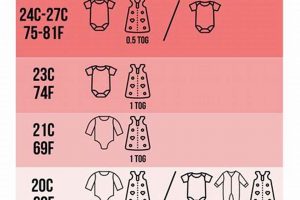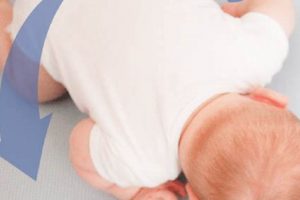Infants transitioning from sleeping on their back to their side represent a common developmental milestone. This positional change typically emerges as motor skills improve, allowing the child greater control over their body. Instances of this activity are often observed as babies gain strength and coordination.
The ability to shift positions during sleep offers potential advantages, including increased comfort and the potential for easier self-soothing. Historically, infant sleep positions have been a subject of research and recommendations, with current guidelines primarily emphasizing back-sleeping to reduce the risk of Sudden Infant Death Syndrome (SIDS). Therefore, parental awareness of a child’s rolling ability is critical for maintaining a safe sleep environment.
Understanding the factors influencing a baby’s sleep posture, potential safety considerations related to side-sleeping, and strategies for ensuring a safe sleep environment are important topics for parents and caregivers. Further exploration of these areas provides valuable insights into promoting infant well-being during sleep.
Guidance Regarding Infant Lateral Sleep Positioning
The following recommendations address concerns arising from a baby’s propensity for lateral positioning during sleep. Implementation of these strategies aims to mitigate potential risks and promote a secure sleep environment.
Tip 1: Maintain Back Sleeping as the Initial Position: Consistently place the infant on their back for the commencement of each sleep period. This practice aligns with established recommendations for reducing the risk of Sudden Infant Death Syndrome (SIDS).
Tip 2: Ensure a Firm Sleep Surface: Utilize a crib mattress that is firm and fits snugly within the crib frame. Avoid soft bedding, including pillows, comforters, and loose blankets, as these pose suffocation hazards.
Tip 3: Remove Potential Hazards from the Crib: Eliminate any toys, bumpers, or other objects from the crib environment. These items can increase the risk of entrapment or suffocation.
Tip 4: Supervise During Awake Tummy Time: Encourage supervised “tummy time” during awake periods to promote the development of neck and shoulder muscles, which may aid in motor control and potentially reduce the likelihood of remaining in a compromised lateral position during sleep.
Tip 5: Monitor Infant Sleep Position: Regularly observe the infant’s sleep position, particularly during the initial stages of independent rolling. While repositioning the infant back to their back is generally recommended, constant vigilance is paramount.
Tip 6: Consider a Wearable Sleep Sack: Employ a wearable sleep sack designed to restrict arm movement without inhibiting leg movement. This can help limit the baby’s ability to fully roll over.
Tip 7: Consult with a Pediatrician: Seek guidance from a healthcare professional regarding any concerns or specific circumstances related to the infant’s sleep position. Individualized recommendations can address specific health conditions or developmental considerations.
Adherence to these guidelines, coupled with continuous monitoring, supports a safer sleep environment for infants who demonstrate a tendency to shift to a lateral sleeping position. Prioritizing safety and informed decision-making is crucial for infant well-being.
Further research into individual risk factors and ongoing consultation with healthcare providers remains essential for establishing optimal infant sleep practices.
1. Motor Skill Development
Infant motor skill development serves as a foundational prerequisite for the ability to shift from a supine (back-lying) position to a lateral (side-lying) position during sleep. The acquisition of sufficient neck strength, core stability, and coordinated limb movements enables the infant to initiate and complete the rolling action. For instance, an infant typically begins to develop the ability to lift their head during tummy time, building the necessary neck muscles. As their core strength increases, they may attempt to push up with their arms, leading to accidental or intentional side-to-side movements. These early movements are precursors to the coordinated rolling motion. Without adequate motor skill development, an infant will lack the physical capacity to change their sleep position, remaining in the position in which they were initially placed.
The timeline for motor skill development can vary significantly among infants. Some may exhibit early rolling behavior, while others reach this milestone later in their development. External factors, such as the amount of time spent in prone position during waking hours (tummy time) and the presence of any underlying medical conditions or developmental delays, can influence the rate of motor skill acquisition. A delayed progression in motor skills may indicate a need for intervention, such as physical therapy, to address any potential limitations. The development of specific motor milestones is directly associated with the propensity for and the actual occurrence of positional changes during sleep.
In summary, motor skill development is an essential determinant in an infant’s capacity to change position while sleeping. Recognizing the importance of these developmental milestones allows caregivers to anticipate potential changes in sleep position, enabling the creation of a safe and supportive sleep environment. Careful observation of motor skill progression and, if needed, seeking early intervention are crucial in optimizing infant well-being. These efforts will reduce the possibility of complications caused by unintended rolling.
2. SIDS Risk Mitigation
Sudden Infant Death Syndrome (SIDS) remains a significant concern in infant care, and understanding the relationship between infant sleep position and SIDS risk is paramount. An infant’s transition to independent rolling, specifically to a side-lying position during sleep, introduces a layer of complexity to SIDS risk mitigation strategies. Adherence to established guidelines becomes even more critical as infants gain mobility.
- Initial Sleep Position and Risk
Placing an infant on their back for sleep is the cornerstone of SIDS prevention. Studies have consistently demonstrated a correlation between back-sleeping and a reduced incidence of SIDS. When an infant rolls to their side, they may subsequently roll onto their stomach, a position associated with an elevated SIDS risk. Therefore, maintaining the back-sleeping position as the initial posture is crucial, even as the infant develops rolling capabilities.
- The Unpredictability of Infant Movement
Once an infant can roll, predicting their sleep position becomes challenging. While parents may initially place the infant on their back, the child may independently transition to their side or stomach. This unpredictability necessitates heightened vigilance and a proactive approach to maintaining a safe sleep environment. Continuous monitoring and awareness of the infant’s rolling abilities are essential components of SIDS risk mitigation.
- Safe Sleep Environment Modification
The ability to roll necessitates a reassessment of the sleep environment. Ensuring a firm mattress, free of soft bedding, pillows, and toys, is crucial in minimizing suffocation hazards. These items can pose a greater risk if the infant rolls onto their stomach. The removal of potential obstructions from the crib environment is a critical step in mitigating SIDS risk.
- Importance of Vigilance and Consistency
As the infant’s rolling abilities increase, parental vigilance and consistency become more important than ever. Parents and caregivers should consistently monitor the infant’s sleeping position. Although caregivers should reposition the infant on their back when possible, especially if they are found sleeping on their stomach, vigilance is critical. Parental and caregiver knowledge of SIDS risk and ability to maintain a safe sleep environment is crucial during this developmental period.
In conclusion, the interaction between an infant’s propensity to roll to their side while sleeping and SIDS risk mitigation underscores the importance of adhering to safe sleep guidelines. Parents and caregivers must be vigilant in maintaining a safe sleep environment, emphasizing back-sleeping, and monitoring the infant’s position throughout the night. Consistent adherence to these recommendations is vital in reducing the risk of SIDS as the infant develops and gains mobility.
3. Safe Sleep Environment
The propensity for an infant to assume a lateral (side) position during sleep necessitates a meticulous examination and adaptation of the sleep environment. The established recommendations for safe infant sleep, primarily focused on preventing Sudden Infant Death Syndrome (SIDS), are predicated on a supine (back) sleeping posture. When an infant demonstrates an inclination to roll onto their side, the existing safe sleep guidelines must be rigorously applied and potentially augmented to address the increased mobility and potential risks associated with this developmental milestone.
The composition of the sleep surface becomes critically important. A firm mattress, conforming to safety standards, is essential. Soft bedding, including loose blankets, pillows, and plush toys, must be entirely absent from the crib. These items pose a suffocation hazard, particularly if the infant rolls onto their stomach. Real-world instances tragically illustrate the danger of soft bedding, where infants have become entrapped and unable to breathe. Similarly, crib bumpers, once commonly used, are now discouraged due to the risk of suffocation and entrapment. The crib should ideally contain only the infant, dressed in appropriate sleepwear such as a sleep sack, which restricts arm movement while allowing leg movement.
Furthermore, the positioning of the crib within the room is a significant consideration. The crib should be placed in a location free from hazards such as dangling cords or loose window coverings, which could present a strangulation risk. Regular inspection of the sleep environment is crucial to identify and eliminate any potential dangers. In summary, the creation and maintenance of a safe sleep environment are directly and inextricably linked to an infant’s rolling ability. The existing safe sleep recommendations serve as a baseline, requiring reinforcement and vigilant monitoring as the infant’s mobility increases. Consistent adherence to these principles is vital in mitigating the risks associated with infant sleep.
4. Parental Vigilance Required
The propensity of an infant to shift to a lateral or prone position during sleep significantly elevates the necessity for heightened parental vigilance. This vigilance serves as a critical safeguard in mitigating potential risks associated with unsupervised positional changes, particularly concerning Sudden Infant Death Syndrome (SIDS) and suffocation hazards. As infants develop the motor skills to roll, continuous parental observation and awareness become indispensable components of a comprehensive safe sleep strategy.
- Continuous Monitoring of Sleep Position
Active monitoring of the infant’s sleep position, particularly during the initial phases of independent rolling, is paramount. Parents and caregivers must regularly check on the infant to ensure they have not transitioned to a potentially unsafe position, such as face-down. For example, consistent checks throughout the night can help identify instances where the infant has rolled onto their stomach, allowing for gentle repositioning back to the supine position. Failure to monitor the infant’s position can increase the risk of airway obstruction or suffocation, particularly if soft bedding is present.
- Environmental Hazard Assessment
Rolling introduces the possibility of the infant encountering previously inaccessible hazards within the sleep environment. Cords, loose blankets, and crib bumpers, which may have posed a minimal risk to a stationary infant, now present a greater danger of entanglement or suffocation. A thorough and ongoing assessment of the sleep environment is crucial to identify and eliminate these potential risks. Real-world instances have highlighted cases where infants have become entangled in cords or suffocated against crib bumpers after rolling. Vigilant parents ensure that the crib remains free of any loose items that could pose a threat.
- Adaptation of Sleep Practices
As the infant’s rolling ability develops, parental sleep practices may need to be adjusted to accommodate the increased mobility. This might involve modifying the swaddling technique or transitioning to a sleep sack that restricts arm movement. Additionally, parents may need to adjust their own sleep schedules to facilitate more frequent monitoring of the infant. For instance, some parents opt to keep the crib in their own bedroom for the first several months to allow for easier observation. Neglecting to adapt sleep practices can increase the risk of the infant assuming an unsafe position without immediate parental intervention.
- Knowledge of Safe Sleep Guidelines
Effective parental vigilance is predicated on a thorough understanding of current safe sleep guidelines. Parents and caregivers must be well-informed about the recommendations for preventing SIDS and suffocation, including the importance of back-sleeping, a firm sleep surface, and a clutter-free crib. Furthermore, they should be aware of the signs of infant distress and know how to respond appropriately in emergency situations. A lack of knowledge regarding safe sleep practices can compromise the effectiveness of parental vigilance and increase the risk of adverse outcomes.
The convergence of infant rolling capabilities and the ongoing imperative for SIDS prevention underscores the critical importance of parental vigilance. Continuous monitoring, environmental hazard assessment, adaptation of sleep practices, and a comprehensive understanding of safe sleep guidelines are essential components of a robust strategy to protect the infant during this developmental phase. Such vigilance serves as a proactive measure to mitigate risks and promote a secure sleep environment. Ensuring infant safety is a shared responsibility of parents and caregivers. Consistently implementing safe sleep practices is the most effective way to minimize SIDS risk.
5. Developmental Readiness Variances
The age at which infants begin to exhibit the capacity to roll onto their side during sleep demonstrates significant variability. These differences in developmental readiness underscore the necessity for individualized assessment and customized application of safe sleep practices. Factors influencing this variance range from inherent biological predispositions to environmental influences and the rate of motor skill acquisition.
- Neuromuscular Maturation Rate
The pace of neuromuscular maturation directly impacts the timing of rolling milestones. Infants experience varying rates of neurological development, influencing the coordination and strength necessary for rolling. Some infants may possess an innate predisposition for earlier motor skill development, while others progress at a slower, yet equally normal, rate. This natural variation highlights the importance of avoiding rigid expectations and recognizing that each infant proceeds according to their unique developmental trajectory. For example, an infant with a more rapid neuromuscular maturation may exhibit rolling behavior as early as three months, while another infant may not achieve this milestone until six months or later.
- Environmental Stimulation and Opportunity
The level of environmental stimulation and opportunities for physical activity can influence motor skill development. Infants who are regularly provided with supervised “tummy time” and engaging play experiences may develop the necessary muscle strength and coordination more quickly than those with limited exposure to such activities. The provision of a stimulating and supportive environment can facilitate the development of motor skills, potentially impacting the timing of rolling milestones. Caregivers play a significant role in fostering this development.
- Weight and Body Composition
Infant weight and body composition can influence rolling ability. Infants with a lower body mass index may find it easier to initiate and complete the rolling motion due to reduced physical resistance. Conversely, infants with a higher body mass index may require greater strength and coordination to overcome the increased physical inertia. These physical factors contribute to the overall variability in developmental readiness for rolling.
- Underlying Medical Conditions
The presence of underlying medical conditions or developmental delays can significantly impact the timing of rolling milestones. Infants with hypotonia (low muscle tone) or other neuromotor impairments may experience delays in motor skill acquisition, including rolling. Early identification and intervention for these conditions are crucial to support optimal motor development. Healthcare professionals play a vital role in identifying and addressing underlying medical conditions that may affect developmental readiness.
In summary, the concept of developmental readiness variances underscores the importance of avoiding standardized expectations and recognizing the individuality of each infant’s developmental journey. Neuromuscular maturation, environmental factors, body composition, and the presence of underlying medical conditions all contribute to the variability observed in the timing of rolling milestones. These variances necessitate a flexible and individualized approach to safe sleep practices, emphasizing parental vigilance and continuous monitoring of the infant’s sleep position and environment. Parents should understand that a baby starting to roll is a normal part of their development and adjust their sleep safety precautions accordingly.
Frequently Asked Questions
The following questions and answers address common concerns and misconceptions regarding infants who roll to their side during sleep. These responses aim to provide accurate and evidence-based information to promote safe sleep practices.
Question 1: Is it safe for an infant to sleep on their side?
Current recommendations emphasize placing infants on their back for sleep to reduce the risk of Sudden Infant Death Syndrome (SIDS). While an infant may independently roll to their side, the initial sleep position should consistently be on the back. If an infant rolls onto their side, close monitoring is necessary.
Question 2: What should be done if an infant rolls onto their stomach while sleeping?
If an infant is observed sleeping on their stomach, the infant should be gently repositioned onto their back. Consistent repositioning is advised, as stomach-sleeping is associated with an increased SIDS risk. Parental monitoring and consistent attempts to place the infant on their back are crucial.
Question 3: Does the presence of rolling necessitate changes to the sleep environment?
The ability to roll necessitates a reassessment of the sleep environment. A firm mattress, free from soft bedding, pillows, toys, and crib bumpers, is essential. These items pose a suffocation hazard, particularly if the infant rolls onto their stomach.
Question 4: At what age do infants typically begin rolling over?
Infants typically begin rolling over between 4 and 7 months of age, though this timeline can vary. Individual development determines when rolling begins. Parental awareness of these developmental milestones is imperative to maintain a safe sleep environment.
Question 5: How does tummy time impact the risk associated with infant sleep positioning?
Supervised “tummy time” during awake hours promotes the development of neck and shoulder muscles. This can aid in motor control and may reduce the likelihood of remaining in a compromised lateral or prone position during sleep. It does not eliminate the importance of back-sleeping as an initial position.
Question 6: When is it appropriate to seek professional medical advice regarding infant sleep positioning?
Consultation with a healthcare professional is recommended when concerns arise regarding an infant’s sleep position, especially if there are underlying medical conditions or developmental delays. Individualized recommendations can address specific health considerations and promote safe sleep practices.
These FAQs are intended to provide general guidance. The information herein should not substitute professional medical advice. Consistently consult a pediatrician or healthcare provider for individualized recommendations regarding infant sleep safety.
Understanding that parental vigilance is key, continue to the final conclusion.
Baby Rolls to Side While Sleeping
The tendency of infants to transition to a side-lying posture during sleep necessitates a comprehensive understanding of related safety implications. Key considerations include the developmental timeline of infant motor skills, the persistent risks associated with SIDS, the criticality of maintaining a safe sleep environment, and the imperative of consistent parental vigilance. Variations in developmental readiness underscore the need for individualized assessment and tailored application of safe sleep practices.
Ongoing research and dissemination of evidence-based recommendations remain crucial in mitigating potential risks associated with infant sleep positioning. Continued diligence and informed decision-making on the part of caregivers are essential for optimizing infant well-being and promoting a secure sleep environment. The pursuit of improved understanding and adherence to best practices in infant sleep safety should remain a paramount objective for all stakeholders.







